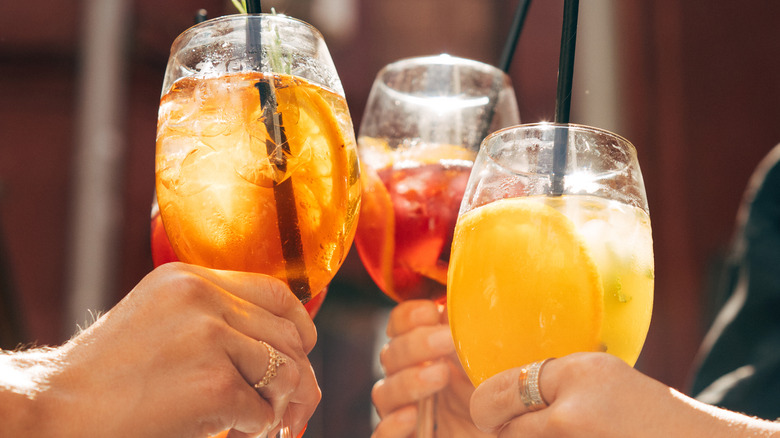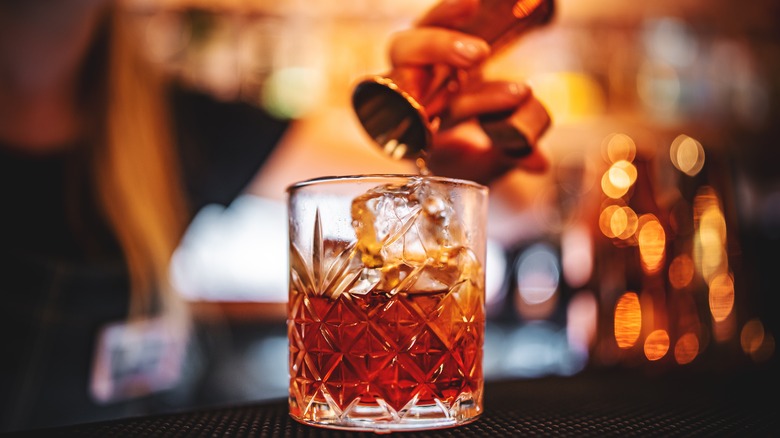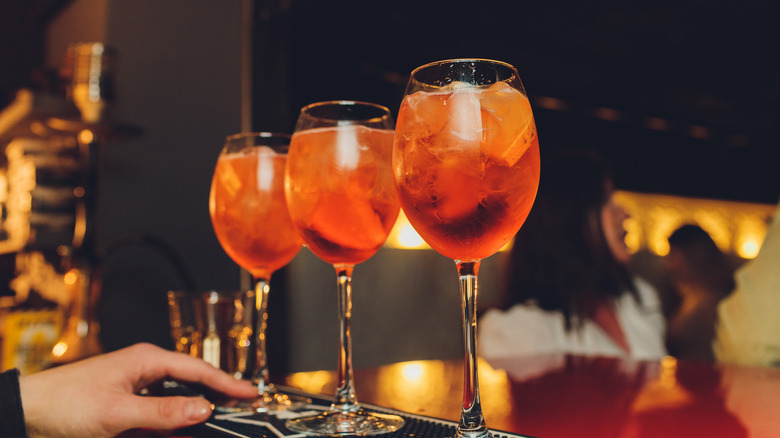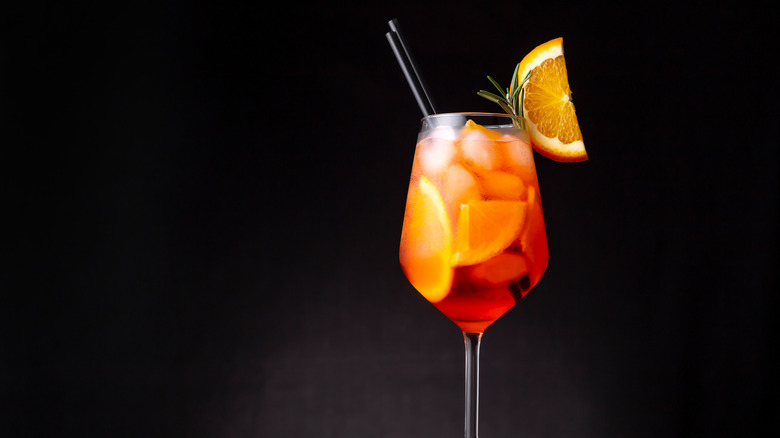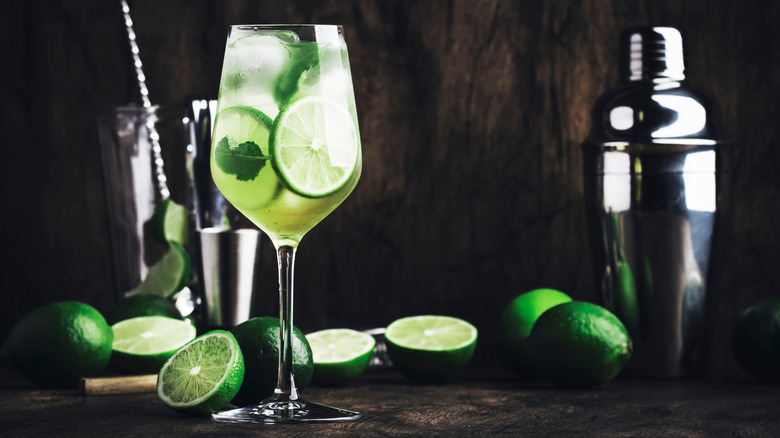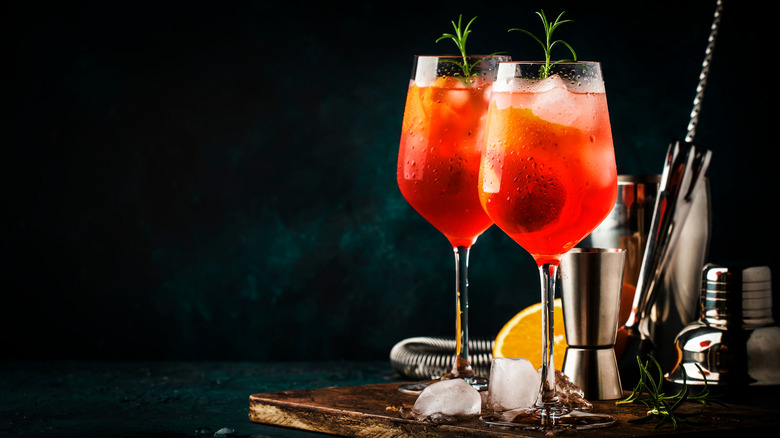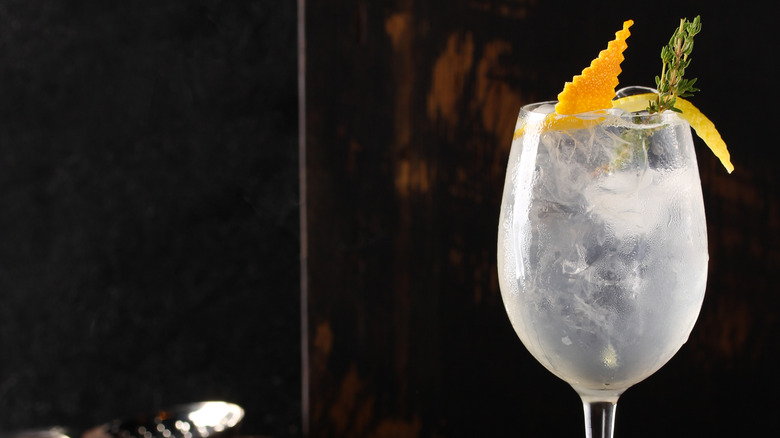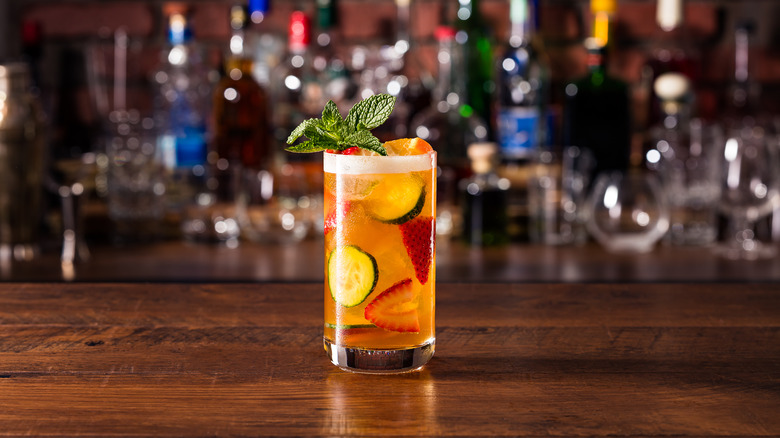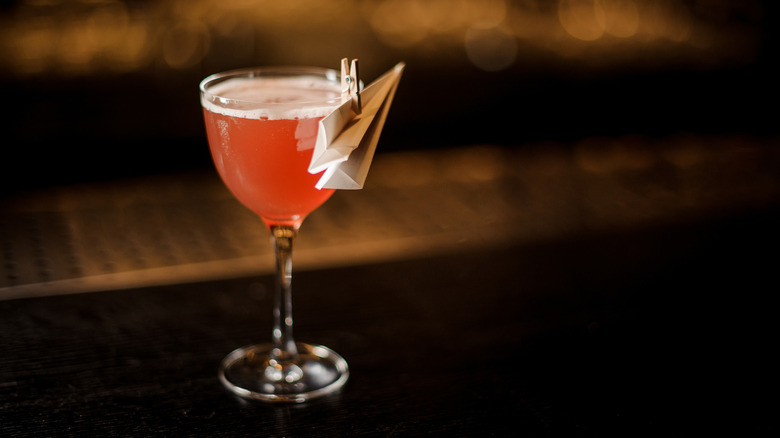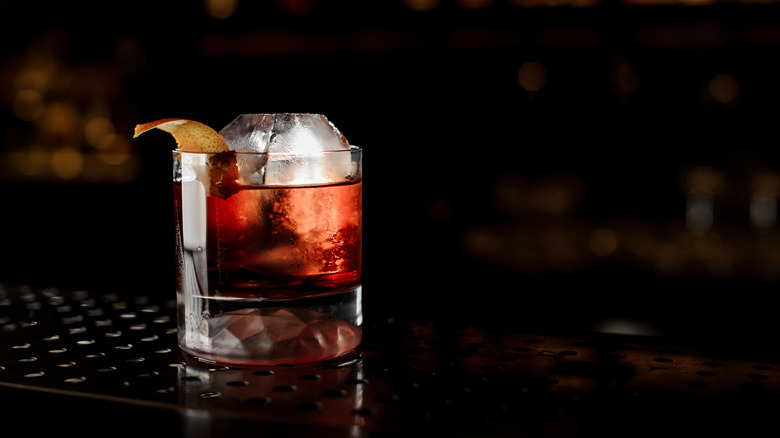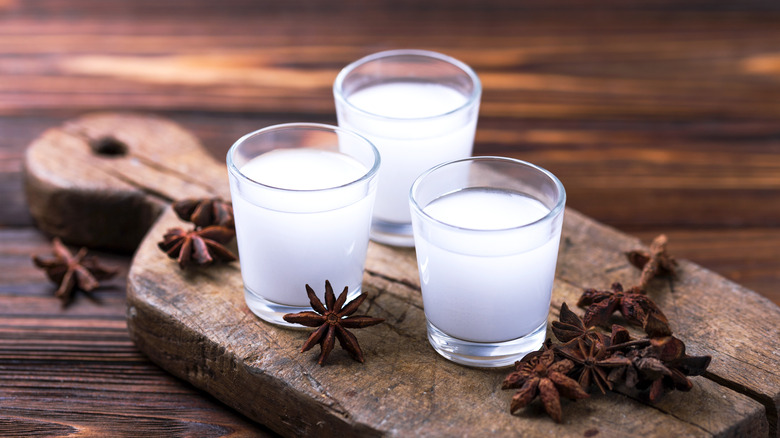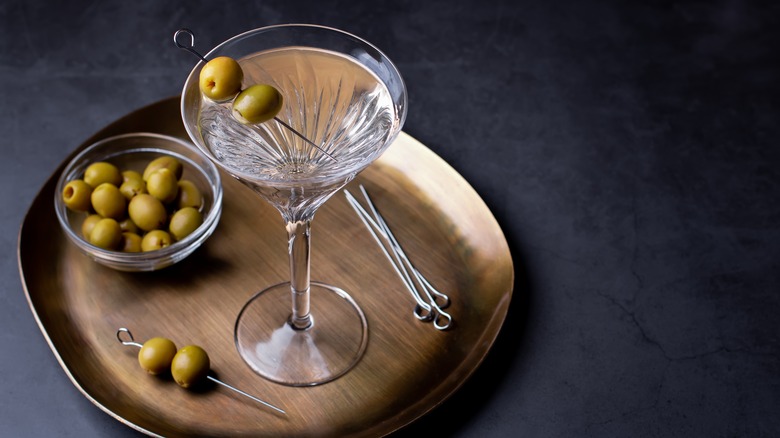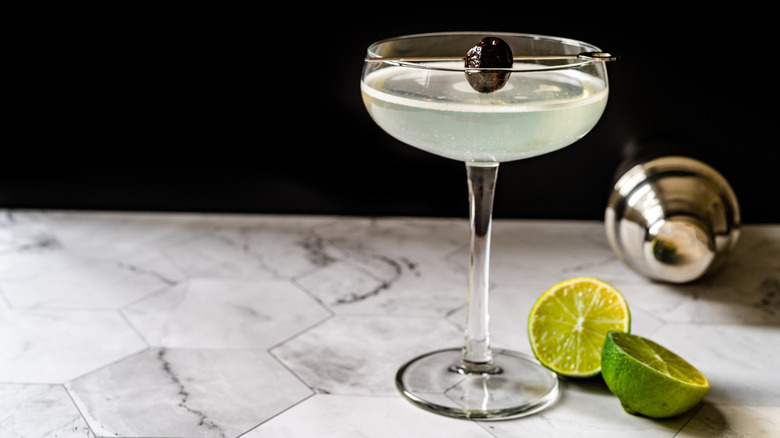The 13 Absolute Best Aperitif Cocktails
The purpose behind a cocktail is often the simple desire for a tasty drink to mark a special occasion, celebrate time with friends or family, or relax at the end of the week. Most people have their go-to drinks they rely on no matter the occasion, but the sips you take from your glass can function as even more than pure enjoyment.
The word "aperitif" translates to "to open" in Latin, and that is exactly what these liqueurs do, according to Advanced Mixology. Aperitifs ignite your taste buds and digestion, preparing you to receive whatever is set to follow. These purposefully bitter liqueurs signal your stomach to begin the digestive process, prematurely releasing the fluids necessary to break down food, like getting a head start. Now, you've had a delicious libation and are ready to dig into whatever comes next. Aperitifs are essentially the flip side of digestifs, which are spirits or after-dinner cocktails meant to close out an evening of food and drink.
Although aperitifs can be enjoyed on their own, the category contributes to a wide array of straightforward, easy-to-make cocktails that'll do more than provide a boozy treat at the beginning of the evening. Aperitifs are meant to be more easily sipped on, usually containing a lower amount of alcohol. The aperitif cocktails on this list, however, will provide a wide-variety fit for satisfying whatever you are looking for. Some are iconic classics, some are recent revelations, and all deserve a try.
Negroni
The classic Negroni cocktail is the mother of all aperitifs. This iconic Italian drink was first created in Florence in 1919 when Count Camillo Negroni requested that his Americano cocktail, consisting of sweet vermouth, Campari, and club soda, be strengthened (via Conde Nast Traveler). The bartender obliged and swapped the club soda for London Dry Gin, and the Negroni was born.
The main aperitif in the Negroni, or aperitivo (Italian), is Campari. The deep red, intensely bitter liqueur is made from an infusion of herbs and spices, the exact specifications of which are still kept secret. Sweet vermouth is also considered an aperitif, so the two together, combined with gin in equal parts, make for a beautifully balanced, sharp, unique drink well-suited to accompany some antipasti.
There is nothing like a Negroni, but the taste for Campari can best be described as an acquired one. The liqueur is quite bitter, but when mixed with the other two ingredients in this cocktail, its full character is tamed and subdued. Once you've acquired the taste for the Italian aperitivo, however, the doors will be opened to the countless riffs on Negroni variations it inspired, including the next cocktail on this list.
Negroni Spagliato
Some cocktails are born out of careful calculations and others out of rigorous trial and error, but there are also those born out of blatant blunders. Per La Cucina Italiana, the Negroni Spagliato, or "wrong Negroni," was first created by Mirko Stocchetto, a bartender working at Bar Basso in Milan in 1972. After a customer ordered a Negroni, Stochetto added sparkling wine to the mix of sweet vermouth and Campari instead of gin. The customer loved it, so it stuck.
Because of the gin replacement with sparkling wine, the Spagliato, or Negroni Sbagliato cocktail, is a lower ABV beverage perfect for getting the night going. At a point in the night where one or more drinks most likely follow, a cocktail containing less alcohol is a great option to pace yourself while not sacrificing taste or the qualities of a great aperitif. This Negroni variation will not only whet your appetite, the sparkling wine brightens this drink to elevate it as a pairing for pre-dinner finger foods. The Negroni Spagliato is a vibrant, instant classic that you will surely be coming back to again and again.
Aperol Spritz
The Aperol Spritz may be the most popular and widely-known cocktail on this list, but this summer staple and forever menu mainstay wasn't born yesterday. In fact, this drink has now been around and thriving for decades.
The liqueur itself dates back to 1919, when Italian brothers Luigi and Silvio Barbieri founded Aperol in Padua. According to Tuscany Now and More, the aperitivo was an instant hit, but it was not until the 1950s when experimentation created the bubbly cocktail we all know and love today. It was actually a commercial television advertisement showing the Aperol Spritz recipe that ignited its popularity and eventually pushed Campari aside to second in command.
The simple three-ingredient combination of a classic Aperol Spritz recipe — Aperol, sparkling wine, and soda water — has made the Aperol Spritz a go-to cocktail for brunch and summer evenings since. In 2002, Campari purchased the Aperol brand, and the two now dominate the aperitivo scene together.
Aperol is also a liqueur made from fruits, herbs, and spices, but its palatability compared to Campari is far milder. Aperol is still bitter but is more approachable, hence the Aperol Spritz's sustained easy-sipping popularity.
Hugo Spritz
The Hugo is another spritz cocktail, but the first drink on our list not to feature an Italian aperitivo. The cocktail consists of sparkling wine, mint, and elderflower liqueur. St. Germain is the only elderflower liqueur you need to know. It contributes to so many iconic drinks and earned the nickname "bartender's ketchup" because of its versatility, widespread appeal, and ability to heighten so many recipes.
The first Hugo Spritz was mixed in 2005 by bartender Roland Gruber in the Italian town of Naturno, found in the South Tyrol region. This cocktail is super popular in the region's summer months, as well as in Germany and Austria, per Monkeys and Mountains. The Hugo is another low ABV cocktail that is the perfect welcome to guests and a simple sipper to start the night. It's another super simple cocktail to make, and its ingredients are readily available at most every liquor store. Even if you've never heard of St. Germain, your local wine and spirits store will have it in stock, so stake advantage and bring some new refreshments while the warm weather is still here.
Bicicletta
Now, back to the Italian aperitivos! The Bicicletta, or "bicycle" in Italian, got its name because of the older customers who would swerve home on their bicycle ride home after enjoying a few of these at the cafe, according to Punch Drink.
If you like an Aperol Spritz, the Bicicletta is calling your name. But if you've tried Campari before and think it's not for you, it's time to revisit it with this deliciously balanced spritz cocktail. Simply take an Aperol spritz, swap the Aperol for Campari, the prosecco for dry white wine, and you have a Bicicletta. The only effervescence found in a Bicicletta is from the club soda, which does well to lengthen the other two dry ingredients.
Although it may seem like using a fruitier white wine would make more sense, the sharpness from the pinot grigio or sauvignon blanc you use does well to highlight the fruitier qualities of the Campari. Add an orange wedge or two as a garnish, and this bold, fizzy aperitivo cocktail may be the one that gets you to hop on the Campari bandwagon.
Vermouth Spritz
This spritz is the most basic, straightforward one on this list, consisting of just vermouth and soda water. Drinking vermouth on its own is a perfectly acceptable aperitif, but adding a dash or two of club soda acts as a lengthener that softens the fortified wine, which has a bold and spiced flavor profile that may not suit everyone's taste.
Whether you decide to try dry or sweet vermouth is entirely up to you, the same being for whatever you choose as a garnish. Orange slices are the typical toppings for most of the previous cocktails on this list because the fruit is a natural complement both in aroma and appearance to the bitter, dark red Italian aperitivos. In a Vermouth Spritz, the garnish is whatever you choose. This super simple drink can be accentuated with whatever you might prefer to finish a martini with, for example. Choices such as a lemon twist, or a briny olive, are not so uncommon to drink with vermouth. Some restaurants even serve a Vermouth Spritz with an assortment of garnishes to pick from, making this drink completely customizable and unique to your own taste.
Pimm's Cup
The Pimm's Cup cocktail is an all-time great. This fruit-filled beverage dates all the way back to the mid-19th century and remains a fresh, late-afternoon go-to. Per Britannica, James Pimm founded the Pimm's brand sometime between 1823 and 1840 out of his London oyster bar. The original Pimm's No. 1 is a gin-based liqueur made with quinine and various herbs to aid the digestive process. James Pimm went on to create Pimm's numbers two through six, each based on a different liquor.
The original Pimm's No. 1 is the foundation of this traditional cocktail, consisting of fruity, herbal liqueur, assorted fruits, ginger ale or lemonade, and fresh mint. The fruit or vegetables inside a Pimm's Cup are normally some combinations of cucumber, strawberry, orange, or lemon. These are not muddled, however, but tossed in whole to be enjoyed later as a bonus, boozy snack. This drink is another low ABV cocktail great for getting the evening started or sipping throughout a brunch, but some bartenders will make a Pimm's Cup with an added pouring of London Dry Gin to give it some extra strength.
Since its invention over a century ago, the Pimm's Cup has gone on to become the official cocktail of the Wimbledon tennis championships, where the very first official Pimm's bar opened in 1971. If it's tasty and refreshing enough for Wimbledon, it's certainly earned itself a try.
Intro to Aperol
This aperitif cocktail comes from one of the most famous bartenders in the world today, Audrey Saunders (via Difford's Guide). Based in New York City, Saunders is responsible for many modern cocktails as well as starting the program at the iconic Pegu Club.
The Intro to Aperol is one Saunders invention that is exactly what it sounds like. Aperol is the main player in this simple drink with a supporting cast of gin, lemon juice, and aromatic bitters. This super refreshing cocktail is tart, dry, and bitter on the finish, but only as bitter as aperitivo inside. The orange twist garnish that is called for goes a long way to brighten up this drink and contributes to making it greater than the sum of its parts.
While adding an ounce of gin to this drink, the Intro to Aperol remains driven by the two ounces of Aperol, with the gin present only to stiffen the cocktail and add some proof. If you like Aperol, but seem to have been stuck on the Aperol Spritz, The Intro is the perfect avenue toward many of the other best cocktails to make with Aperol, including the one next on our collection.
Paper Plane
The Intro to Aperol is a modern masterpiece, for sure, but the Paper Plane may be the highest flier of all modern classics. Invented by drinks icon Sam Ross for The Violet Hour in Chicago, the Paper Plane originally contained equal parts bourbon, Campari, Amaro Nonino, and lemon juice (via Punch Drink). A few days later, Ross tried the drink again and found it to be unbalanced. He decided to swap the Campari for Aperol, rounding out the tartness and complimenting the herbal amaro, and the Paper Plane recipe found on menus all over was cemented.
Amaro Nonino is an Italian amaro, which are herbal, syrupy, liqueurs typically enjoyed as a digestif. Amaro Nonino comes from Friuli, Italy, and was invented in 1933. The herbaceous amaro is the perfect accompaniment to the Paper Plane, as its bitter qualities are perfectly counteracted by the Aperol and lemon juice, which are each rounded by the sweeter qualities of the bourbon. The Paper Plane cocktail is credited with spreading the popularity of Amaro Nonino. Elizabetta Nonino thanks Sam Ross for making her family's bottle of Amaro a must-have in every cocktail bar.
If you can get all of these ingredients together, make it the next time you have company over. Those who have tasted it before will be pleased to see it again, and those who haven't will discover a unique, delicious aperitivo cocktail.
American Aperitif
Whiskey is typically enjoyed after dinner, but the Paper Plane and this Americanized aperitif are right up any whiskey drinker's alley. The American aperitif cocktail recipe is a simple, three-ingredient drink that gives you the taste of whiskey, rye in this case, that you want in a cocktail, along with the accompaniment of Campari for that bitter, early evening pick-me-up. It also has an elderflower liqueur to bring the whole combination together.
Rye whiskey is the best option for this cocktail, as its emphasis on spice does well to balance the fruity, herbal notes of the Campari as well as the bright sweetness of the St. Germain. The American aperitif is also a stirred cocktail, not shaken, making it convenient for serving many or just one. The drink does not have any established history or widespread popularity, but if you plan on stocking your home bar to make any of these cocktails, you'd might as well give this one a try too.
Good & Plenty
If you've been waiting for an absinthe cocktail to pop up on this list, you can wait longer, but this next drink does contain an anise-noted spirit that is one of a kind. Old Sugar Distillery produces an Americanaki Ouzo, which is a Greek liquor that, in this case, urges absinthe to take on anise flavors while supporting the distillery's domestic take on an iconically bitter liqueur.
While absinthe is now commonly used as a rinse or sometimes sprayed onto glass with an atomizer, this ouzo can be used as the main ingredient in a cocktail. The Good and Plenty cocktail recipe features the aforementioned spirit, along with maple syrup, lemon juice, and dry white wine. The maple syrup acts as a richer alternative to simple syrup, seemingly a requirement to balance out the 90-proof spirit. For those who may find absinthe too harsh for their palate, giving a Greek spirit a try is only fair. If you have a taste for absinthe, this one is a no-brainer.
Dirty Martini
Anyone who likes a martini is sure to be strict about their personal specifications regarding this definitive cocktail. After all, it can come in a wide variety of forms. As far as Dirty Martinis go, most people either love them or hate them, and if you've never had one before, giving it a try is worth it to find out which side you live on.
The classic dry martini, consisting of dry vermouth and gin, was an instant hit following its conception in the early 1900s. A New York bartender decided to experiment by muddling in some olives, a popular garnish to the drink, and the Dirty Martini got its name. After taking a liking to his creation, the mixing of straight olive juice became the standard, and the Dirty Martini has sustained and polarized ever since. It was even the favorite cocktail of U.S. President Franklin D. Roosevelt.
A regular gin or Kangaroo (vodka) martini is a fine way to begin an evening, but the Dirty Martini recipe turns this cocktail into an excellent aperitif. Because olives are fermented, Lactobacillus is present, a gut-friendly bacteria that promote healthy digestion, according to TIME. Sipping on a Dirty Martini will not only kickstart the evening with a boozy drink, but your stomach will also be sure to thank you for it later on.
Last Word
The Last Word is our last cocktail. According to Spirits Beacon, this Prohibition-era drink was first shaken at the Detroit Athletic Club and gained popularity throughout the next few decades, but eventually faded out and was nearly forgotten until the recent cocktail boom. In 2005, Seattle bartender, Murray Stenson, came across the Last Word in a 1951 book and added it to his menu. It was an instant hit and became even more widely known and enjoyed once it reached the Pegu Club in New York.
The Last Word is another equal parts cocktail (a balance that inspired the Paper Plane), consisting of gin, lime juice, green chartreuse, and maraschino liqueur. The main aperitif here is the green chartreuse, a French liqueur made by Carthusian Monks using over 130 different herbs. The Last Word is the epitome of a balanced drink. Not one component shines above the rest; each can be individually detected and savored.
It's good that The Last Word made its way back into the drinks space and onto bar menus. Now, you can shake one up for yourself and your guests to begin the evening with a timeless aperitif cocktail worthy of a refill.
